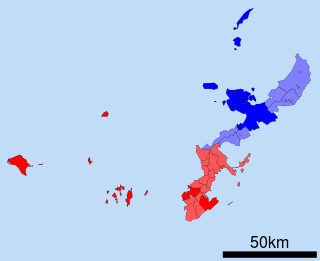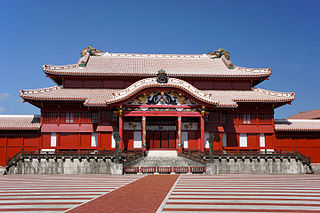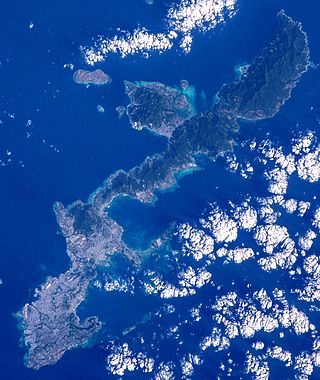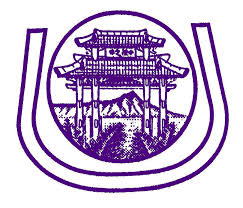
Okinawa Prefecture is a prefecture of Japan. Okinawa Prefecture is the southernmost and westernmost prefecture of Japan and has a population of 1,457,162 and a geographic area of 2,281 km2.

The Ryukyuan people are a Japonic-speaking East Asian ethnic group native to the Ryukyu Islands, which stretch between the islands of Kyushu and Taiwan. Administratively, they live in either the Okinawa Prefecture or the Kagoshima Prefecture within Japan. They speak one of the Ryukyuan languages, considered to be one of the two branches of the Japonic language family, the other being Japanese and its dialects. Hachijō is sometimes considered by linguists to constitute a third branch.

The Okinawan language or Central Okinawan is a Northern Ryukyuan language spoken primarily in the southern half of the island of Okinawa, as well as in the surrounding islands of Kerama, Kumejima, Tonaki, Aguni and a number of smaller peripheral islands. Central Okinawan distinguishes itself from the speech of Northern Okinawa, which is classified independently as the Kunigami language. Both languages are listed by UNESCO as endangered.

The Ryukyuan languages, also Lewchewan or Luchuan, are the indigenous languages of the Ryukyu Islands, the southernmost part of the Japanese archipelago. Along with the Japanese language and the Hachijō language, they make up the Japonic language family.

This article is about the history of the Ryukyu Islands southwest of the main islands of Japan.

Okinawa Island, officially Okinawa Main Island, is the largest of the Okinawa Islands and the Ryukyu (Nansei) Islands of Japan in the Kyushu region. It is the smallest and least populated of the five main islands of Japan. The island is approximately 106 kilometres (66 mi) long, an average 11 kilometres (7 mi) wide, and has an area of 1,206.98 square kilometers (466.02 sq mi). It is roughly 640 kilometres south of the main island of Kyushu and the rest of Japan. It is 500 km northeast of Taiwan. The total population of Okinawa Island is 1,384,762. The Greater Naha area has roughly 800,000 residents, while the city itself has about 320,000 people. Naha is the seat of Okinawa Prefecture on the southwestern part of Okinawa Island. Okinawa has a humid subtropical climate.

The Yaeyama language is a Southern Ryukyuan language spoken in the Yaeyama Islands, the southernmost inhabited island group in Japan, with a combined population of about 53,000. The Yaeyama Islands are situated in the Southern Ryukyu Islands, southwest of the Miyako Islands and to the east of Taiwan. Yaeyama (Yaimamunii) is most closely related to Miyako. The number of competent native speakers is not known; as a consequence of Japanese language policy which refers to the language as the Yaeyama dialect, reflected in the education system, people below the age of 60 tend to not use the language except in songs and rituals, and the younger generation exclusively uses Japanese as their first language. As compared to the Japanese kokugo, or Japanese national language, other Ryukyuan languages such as Okinawan and Amami have also been referred to as dialects of Japanese. Yaeyama is noted as having a comparatively lower "language vitality" among neighboring Ryukyuan languages.

The Amami Islands is an archipelago in the Satsunan Islands, which is part of the Ryukyu Islands, and is southwest of Kyushu. Administratively, the group belongs to Kagoshima Prefecture, Japan. The Geospatial Information Authority of Japan and the Japan Coast Guard agreed on February 15, 2010, to use the name of Amami-guntō (奄美群島) for the Amami Islands. Prior to that, Amami-shotō (奄美諸島) was also used. The name of Amami is probably cognate with Amamikyu (阿摩美久), the goddess of creation in the Ryukyuan creation myth.

The Ryukyu independence movement or the Republic of the Ryukyus is a political movement advocating for the independence of the Ryukyu Islands from Japan.

The Ryukyu Islands, also known as the Nansei Islands or the Ryukyu Arc, are a chain of Japanese islands that stretch southwest from Kyushu to Taiwan: the Ōsumi, Tokara, Amami, Okinawa, and Sakishima Islands, with Yonaguni the westernmost. The larger are mostly volcanic islands and the smaller mostly coral. The largest is Okinawa Island.

Yukatchu, also known as Samuree (サムレー), were the aristocracy of the Ryukyu Kingdom. The scholar-bureaucrats of classical Chinese studies living in Kumemura held the majority of government positions.

Okinawan Japanese is the Japanese language as spoken by the people of Okinawa Islands. Okinawan Japanese's accents and words are influenced by the traditional Okinawan and Kunigami languages. Okinawan Japanese has some loanwords from American English due to the United States administration after the Battle of Okinawa. Okinawan Japanese is a Japanese dialect, unlike the Northern Ryukyuan Okinawan and Kunigami languages.

The Ryukyuan religion (琉球信仰), Ryūkyū Shintō (琉球神道), Nirai Kanai Shinkō (ニライカナイ信仰), or Utaki Shinkō (御嶽信仰) is the indigenous belief system of the Ryukyu Islands.
Most early Asian settlers to the United States went to Hawaii. Most of these early immigrants moved to the islands as laborers to work on the pineapple, coconut, and sugarcane plantations. These early migrants have tended to stay, although a handful returned to their home countries. There has also been recent immigration to Hawaii from more ethnic Asian groups, including the Thai, Indian, Indonesian, and the Vietnamese.
The Ryukyuan diaspora are the Ryukyuan emigrants from the Ryukyu Islands, especially Okinawa Island, and their descendants that reside in a foreign country. The first recorded emigration of Ryukyuans was in the 15th century when they established an exclave in Fuzhou in Ming Dynasty (China). Later, there was a large wave of emigration to Hawaii at the start of the 20th century, followed by a wave to various Pacific islands in the 1920s and multiple migrations to the Americas throughout the 20th century. Ryukyuans became Japanese citizens when Japan annexed the Ryukyu Kingdom in 1879; therefore Ryukyuan immigrants are often labeled as part of the Japanese diaspora. Regardless, some of the Ryukyuan diaspora view themselves as a distinct group from the Japanese (Yamato).
The Okinawans in Hawaii are a Ryukyuan ethnic group, numbering anywhere between 45,000-50,000 people, or 3% of Hawaii’s total population.
Ryukyuan assimilation policies are a series of practices aimed at the Ryukyuan people with the intent of assimilating them into Japanese culture and identity beginning shortly before the Disposition of Ryukyu in 1879 and continuing to the present day.
The Ryukyuans in Brazil are Brazilian nationals of Ryukyuan descent.

The Hawaii United Okinawa Association is a cultural organization for the Okinawan community of Hawaii.
Ryukyuan culture are the cultural elements of the indigenous Ryukyuan people, an ethnic group native to Okinawa Prefecture and parts of Kagoshima Prefecture in southwestern Japan.














